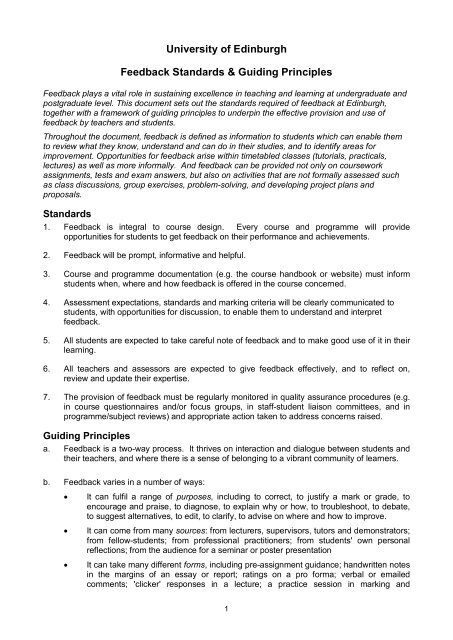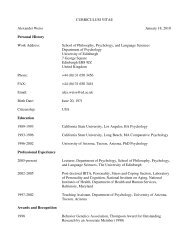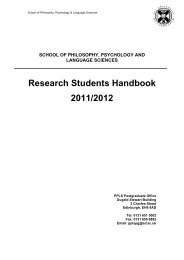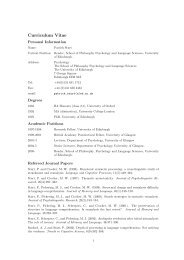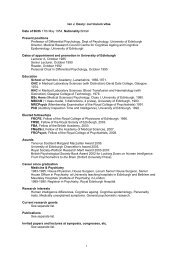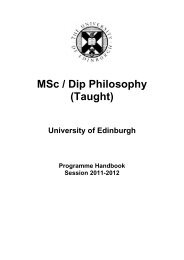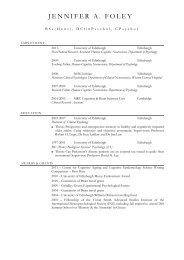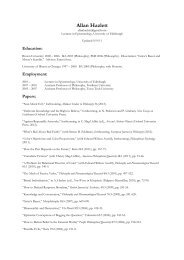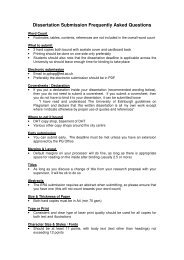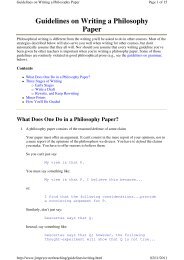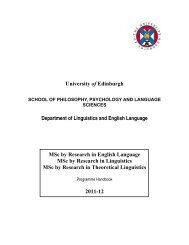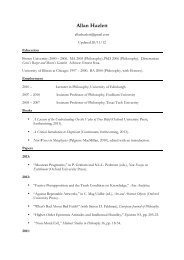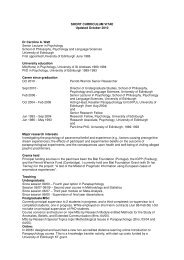University Feedback Standards and Guiding Principles
University Feedback Standards and Guiding Principles
University Feedback Standards and Guiding Principles
Create successful ePaper yourself
Turn your PDF publications into a flip-book with our unique Google optimized e-Paper software.
<strong>University</strong> of Edinburgh<br />
<strong>Feedback</strong> <strong>St<strong>and</strong>ards</strong> & <strong>Guiding</strong> <strong>Principles</strong><br />
<strong>Feedback</strong> plays a vital role in sustaining excellence in teaching <strong>and</strong> learning at undergraduate <strong>and</strong><br />
postgraduate level. This document sets out the st<strong>and</strong>ards required of feedback at Edinburgh,<br />
together with a framework of guiding principles to underpin the effective provision <strong>and</strong> use of<br />
feedback by teachers <strong>and</strong> students.<br />
Throughout the document, feedback is defined as information to students which can enable them<br />
to review what they know, underst<strong>and</strong> <strong>and</strong> can do in their studies, <strong>and</strong> to identify areas for<br />
improvement. Opportunities for feedback arise within timetabled classes (tutorials, practicals,<br />
lectures) as well as more informally. And feedback can be provided not only on coursework<br />
assignments, tests <strong>and</strong> exam answers, but also on activities that are not formally assessed such<br />
as class discussions, group exercises, problemsolving, <strong>and</strong> developing project plans <strong>and</strong><br />
proposals.<br />
<strong>St<strong>and</strong>ards</strong><br />
1. <strong>Feedback</strong> is integral to course design. Every course <strong>and</strong> programme will provide<br />
opportunities for students to get feedback on their performance <strong>and</strong> achievements.<br />
2. <strong>Feedback</strong> will be prompt, informative <strong>and</strong> helpful.<br />
3. Course <strong>and</strong> programme documentation (e.g. the course h<strong>and</strong>book or website) must inform<br />
students when, where <strong>and</strong> how feedback is offered in the course concerned.<br />
4. Assessment expectations, st<strong>and</strong>ards <strong>and</strong> marking criteria will be clearly communicated to<br />
students, with opportunities for discussion, to enable them to underst<strong>and</strong> <strong>and</strong> interpret<br />
feedback.<br />
5. All students are expected to take careful note of feedback <strong>and</strong> to make good use of it in their<br />
learning.<br />
6. All teachers <strong>and</strong> assessors are expected to give feedback effectively, <strong>and</strong> to reflect on,<br />
review <strong>and</strong> update their expertise.<br />
7. The provision of feedback must be regularly monitored in quality assurance procedures (e.g.<br />
in course questionnaires <strong>and</strong>/or focus groups, in staffstudent liaison committees, <strong>and</strong> in<br />
programme/subject reviews) <strong>and</strong> appropriate action taken to address concerns raised.<br />
<strong>Guiding</strong> <strong>Principles</strong><br />
a. <strong>Feedback</strong> is a twoway process. It thrives on interaction <strong>and</strong> dialogue between students <strong>and</strong><br />
their teachers, <strong>and</strong> where there is a sense of belonging to a vibrant community of learners.<br />
b. <strong>Feedback</strong> varies in a number of ways:<br />
· It can fulfil a range of purposes, including to correct, to justify a mark or grade, to<br />
encourage <strong>and</strong> praise, to diagnose, to explain why or how, to troubleshoot, to debate,<br />
to suggest alternatives, to edit, to clarify, to advise on where <strong>and</strong> how to improve.<br />
· It can come from many sources: from lecturers, supervisors, tutors <strong>and</strong> demonstrators;<br />
from fellowstudents; from professional practitioners; from students' own personal<br />
reflections; from the audience for a seminar or poster presentation<br />
· It can take many different forms, including preassignment guidance; h<strong>and</strong>written notes<br />
in the margins of an essay or report; ratings on a pro forma; verbal or emailed<br />
comments; 'clicker' responses in a lecture; a practice session in marking <strong>and</strong><br />
1
commenting on a sample assignment; 'dropin' advice; a supervision meeting; a<br />
debriefing by a professional practitioner; wholeclass feedback on how an exam<br />
question had been tackled<br />
c. <strong>Feedback</strong> needs to be fit for purpose. The particular kinds of feedback that are offered within<br />
any given course or programme unit will vary, depending on what <strong>and</strong> how students are<br />
expected to learn <strong>and</strong> the resources available.<br />
d. Good feedback <strong>and</strong> highquality learning go h<strong>and</strong>inglove. Where feedback is effective, it<br />
can help students to improve what they know, underst<strong>and</strong> <strong>and</strong> are able to do — <strong>and</strong> so attain<br />
their full potential.<br />
e. In order to be effective, feedback needs to be prompt, informative <strong>and</strong> helpful.<br />
· prompt feedback is returned to students within the agreed timescale for the work<br />
submitted;<br />
· informative feedback highlights strengths <strong>and</strong> weaknesses, giving specific examples<br />
or explanations;<br />
· helpful feedback offers suggestions about how to improve.<br />
f. Students’ engagement with feedback thrives when they experience it in a wide range of<br />
forms <strong>and</strong> settings, while gaining practice in acting upon <strong>and</strong> giving feedback as well as<br />
receiving it.<br />
g. Staff expertise in feedback grows when new tutors, demonstrators, supervisors <strong>and</strong> lecturers<br />
are wellsupported in learning how to give feedback effectively in their subject area, <strong>and</strong><br />
when good practice <strong>and</strong> innovation in feedback are shared amongst staff at all levels of<br />
experience. [A website resource has been compiled on Improving <strong>Feedback</strong>, which links a<br />
range of innovative feedback strategies to over 200 caseexamples drawn from across the<br />
subject range <strong>and</strong> from within <strong>and</strong> outwith Edinburgh: www.tla.ed.ac.uk/feedback.htm]<br />
h. <strong>Feedback</strong> can only work well when it is a joint <strong>and</strong> shared responsibility.<br />
The onus is on students to:<br />
• familiarise themselves with when,<br />
where <strong>and</strong> how feedback is provided<br />
• develop their underst<strong>and</strong>ing of<br />
assessment expectations, criteria<br />
<strong>and</strong> st<strong>and</strong>ards in their chosen degree<br />
programme<br />
• collect <strong>and</strong> reflect on the feedback<br />
provided, <strong>and</strong> grasp opportunities to<br />
put it to good use<br />
The onus is on teachers to:<br />
• design courses <strong>and</strong> programmes in<br />
ways that enable students to get <strong>and</strong><br />
to act on feedback<br />
• inform students when, where <strong>and</strong><br />
how feedback will be provided<br />
• provide feedback which is prompt,<br />
informative <strong>and</strong> helpful, within the<br />
resources available to them<br />
i. The quality of feedback is safeguarded when it is monitored <strong>and</strong> when it is valued<br />
appropriately in staff appraisal <strong>and</strong> promotion.<br />
Approved by Senatus on 16 June 2010<br />
2


